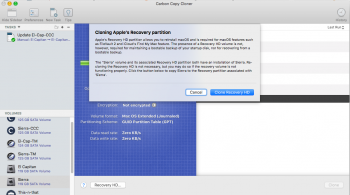I saw this in the other thread:
Ah. Well it's beginning to make sense now. A full time machine restore would have copied back your recovery partition.
But that apparently is not what you did.
You seem to have some major issues now preventing you from creating a proper recovery partition.
So you could either
1. Boot up in internet recovery, reformat the entire drive, do a full time machine restore from the last backup of your complete system (not the corrupted one).
OR
2. Boot up in internet recovery, reformat the entire drive, do a clean install and THEN copy back data with migration assistant.
I had used a Migration, I thought the terms were interchangeable. My mistake.
Ah. Well it's beginning to make sense now. A full time machine restore would have copied back your recovery partition.
But that apparently is not what you did.
You seem to have some major issues now preventing you from creating a proper recovery partition.
So you could either
1. Boot up in internet recovery, reformat the entire drive, do a full time machine restore from the last backup of your complete system (not the corrupted one).
OR
2. Boot up in internet recovery, reformat the entire drive, do a clean install and THEN copy back data with migration assistant.


